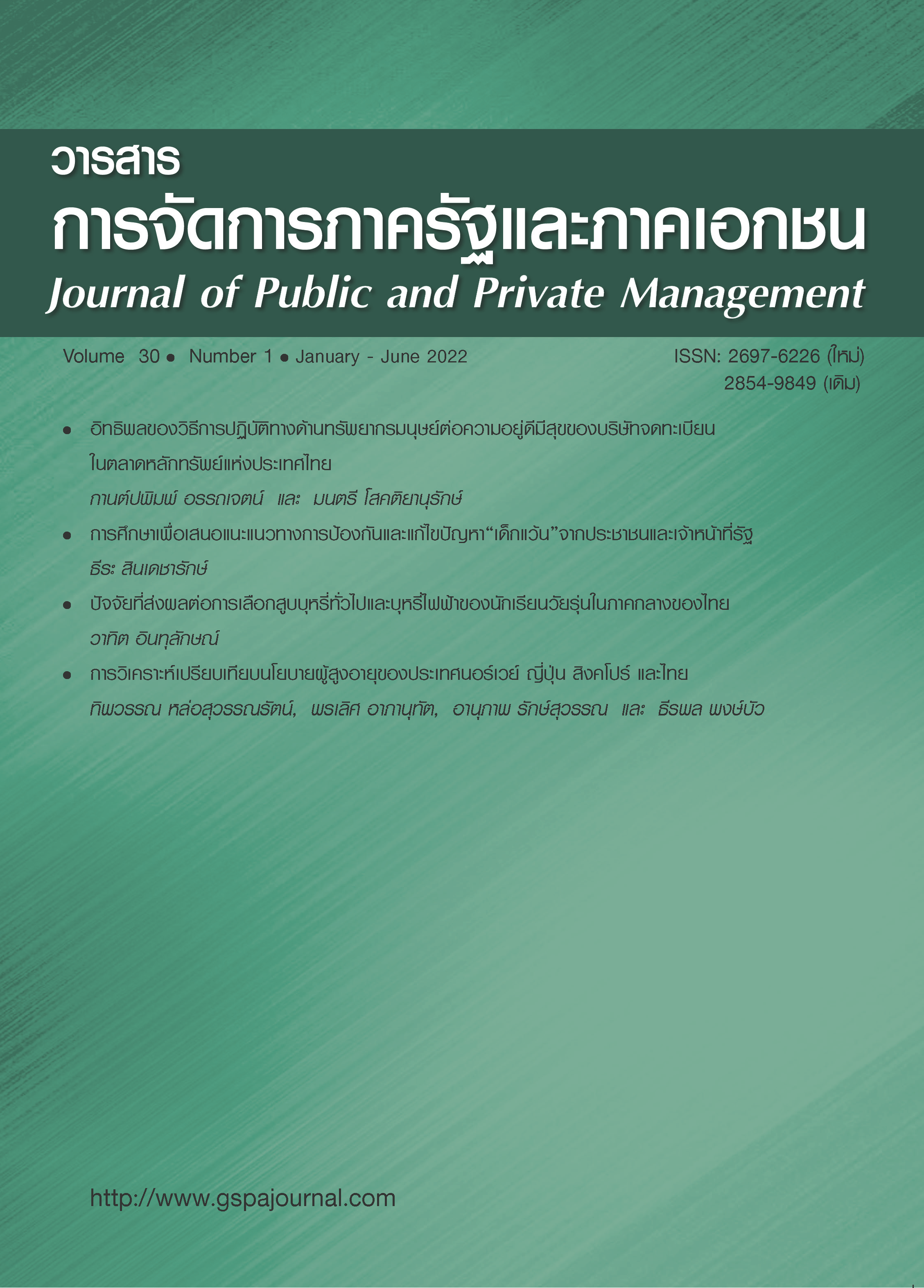The Influences of Human Resources Practices on the Well-Being of the Companies Listed on the SET
Keywords:
Human resource practices, organizational well-being, SET-listed companiesAbstract
This article was aimed at examining the influences of human resources practices on the wellbeing of the companies listed on the stock exchange of Thailand (SET). It employed quantitative research approach and data were collected by questionnaire from the companies listed on the stock exchange of Thailand that received the good governance scores at the level of “Good”, “Very Good”, and “Excellent” during 2016 – 2018. Questionnaires were distributed to 276 companies by postal mails and emails. The data analysis was performed by structural equation modelling. The results revealed that recruitment and selection, training and development, and performance evaluation and promotion were statistically significant at the 0.05 level. Likewise, psychological wellbeing and social wellbeing demonstrated statistical significance at the 0.05 level. In addition, the results obtained from the analysis of structural equation modelling indicated that the goodness-of-fit test was perfect through accepted 6 indices: x2/df = 1.235, p-value = 0.102, GFI = 0.902, CFI = 0.987, RMSEA = 0.049, and SRMR = 0.058. Besides, when it came to the test of the relationship between human resources practices and the wellbeing of the companies listed on the stock exchange of Thailand, it was found that human resources practices could explain the variances of the wellbeing of the companies listed on the stock exchange of Thailand by 98.6 percent with the statistical significance at the 0.01 level.
References
Armstrong, M. (2010). Armstrong's Essential Human Resource Management Practice: A Guide to People Management. London: Kogan Page Publishers.
____________. (2014). Armstrong's Handbook of Human Resource Management Practice. 14th ed. London: Kogan Page Publishers.
Becker, F. (1990). The Total Workplace: Facilities Management and the Elastic Organization. New York: Van Nostrand Reinhold.
Boyd, A. (1997). Employee traps—corruption in the workplace. Management Review, 86(8), 9.
Coleman, B. C. (1997). Job-related injuries, illness take heavy toll. Houston Chronicle, July 28
Diener, E. (1984). Subjective well-being. Psychological Bulletin, 95, 542-575.
Diener, E., Emmons, R. A., Larsen, R. J., & Griffin, S. (1985). The satisfaction with life scale. Journal of Personality Assessment, 49(1), 71-75.
Diener, E., Suh, E. M., Lucas, R. E., & Smith, H. L. (1999). Subjective well-being: Three decades of progress. Psychological Bulletin, 125(2), 276–302.
Grant, A. M., Christianson, M. K., & Price, R. H. (2007). Happiness, health, or relationships? Managerial practices and employee well-being tradeoffs. The Academy of Management Perspectives, 21(3), 51-63.
Guest, D. E. (1997). Human resource management and performance: A review of the research agenda. The International Journal of Human Resource Management, 8(3), 263-276.
International Labour Organization. (2017). Workplace Well-being. Retrieved January 15, 2019 from https://www.ilo.org/safework/areasofwork/workplace-health-promotion-and-well-being/WCMS_118396/lang--en/index.htm.
Institute for Population and Social Research, Mahidol University. (B.E.2561). Well-being in Thailand: Dream or Reality? Nakhon Pathom: Institute for Population and Social Research, Mahidol University.
Noe, R. A., Hollenbeck, J. R., Gerhart, B., & Wright, P. M., (2012). Human Resource Management: Gaining a Competitive Advantage. 8th ed. Glasgow, UK: McGraw-Hill.
Khantawit, A. et al. (B.E.2552). Khan Kamkub Dolae Phuea Sang Munlaka. Bangkok: SET.
Kongchan, A. (B.E.2557). Human Resource Management. Bangkok: Pabpim.
Luecha, T., Nantapetch, K., & Krivart, K. (B.E.2561). Happiness at work enhancement for municipality city officers model. Academic Journal Phranakhon Rajabhat University, 9(2), 134-152.
Pfeffer, J. (1998). Seven practices of successful organizations. California Management Review, 40(2), 96-124.
Price, R. H., & Hooijberg, R. (1992). Organizational exit pressures and role stress: Impact on mental health. Journal of Organizational Behavior, 13(7), 641-651.
Rath, T., & Harter, J. (2010). Wellbeing: The Five Essential Elements. New York: Gallup Press.
Rojniruttikul, N. (2009). Organizational Health and Human Resource Management. Dissertation, Doctor of Public Administration, Graduate School of Public Administration, National Institute of Development Administration.
Steele, F. I., & Jenks, S. (1977). The Feel of the Work Place. Reading, MA: Addison-Wesley.
Stokols, D., Churchman, A., Scharf, T., & Wright, S. (1990). Worker’s experiences of environment change and transition at the office. In Fisber, S., & Cooper, C. L. On the Move: The Psychology of Change and Tourism. Chichester: John Wiley & Sons.
Tabachnick, B. G., & Fidell, L. S. (2007). Using Multivariate Statistics. 5th ed. New York: Allyn and Bacon.
Thongtanunam, Y. et al. (B.E.2558). Factors associated with happy workplace (public sector organization): A systematic review. Journal of Health Science Research, 9(1), 52-62.
Tirathamcharoen, P. (B.E.2557). Roles of leader, internal factors and human resource policies and being a healthy organization: A case study of DHL (Thailand) in Eastern Seaboard Industrial estate, Journal of Interdisciplinary Research: Graduate Studies, 3(1), 197-124.
Tseng, Y., & Lee, T. (2009). Comparing appropriate decision support of human resource practices on organizational performance with DEA/AHP model. Expert Systems with Applications: An International Journal, 36(3), 6548-6558.
Visaetsilapanonta, P., & Ramrong, T. (B.E.2557). Ongkorn sukkapawa tonbab. In Jiawiwatkul, A. (Editor). Sansara Ongkorn Haeng Kwamsuk Leam 3: Naewkid Lae Kruengmue Kan Kub Kruen Ngan. Bangkok: P. A. Living.
Wedchayanon, N. (B.E.2554). Change in personnel administration in the Thai public sector from the 20th century to the beginning of the 21st century. NIDA Development Journal, 51(1), 123-155.
______________. (B.E.2559). Strategic Human Capital Management. 2nd edition. Graduate School of Public Administration, National Institute of Development Administration.
World Health Organization. (2010). WHO Healthy Workplaces: A Model for Action, for Employers, Workers, Policy-Makers and Practitioners. Geneva: World Health Organization.
Yepitak, P., Chantuk, T., & Siriwong, P. (2018). The phenomenon enhancing wellbeing in multi-complex organizations of working age: A study for grounded theory. Veridian E-Journal, Silpakorn University, 11(1), 633-644.
Downloads
Published
How to Cite
Issue
Section
License

This work is licensed under a Creative Commons Attribution-NonCommercial-NoDerivatives 4.0 International License.



